Aquamarine
Blue variety of Beryl
Aquamarine shop
Origin of Name: latin: aqua marina = seawater
Can be confused with: aquamarine can easily be confused with blue topaz. Naturally coloured topaz is very rare but irradiated topaz of sky blue colour is common. Other topaz colours produced by irradiation, are London blue and Swiss blue. These two colours, however, are too intense and unnatural to fool the expert.
Identification is simple. Topaz has a much higher specific gravity than beryl. Thus topaz feels much heavier than aquamarine of equal size. The refractive index of topaz is also significantly higher than that of beryl.
Frequently one encounters synthetic spinels of aquamarine colour. Almost always these stones are incorrectly termed synthetic aquamarine when in fact synthetic aquamarine does not exist (yet?).
Again, identification is simple. Spinel (synthetic or natural) is singly refractive, a fact which can easily be established by an inexpensive optical tool called the dichroscope. Besides, synthetic spinel always suffers from so-called anomalous double refraction, which is caused by inner tension. This produces a tell-tale behaviour when rotated between crossed polars which in gemmological literature is called "tabby extinction".
And last but not least, aquamarine coloured synthetic spinel turns slightly but diagnostically pinkish under the Chelsea Filter, another inexpensive tool every gem lover should possess.
Localities: aquamarine is very common world wide. By far the most important source is Brazil. Other locations of significant commercial impact are Nigeria, Moçambique, Madagascar and Pakistan. Sources of less commercial importance are India, Sri Lanka, Afghanistan and the USA, to name just a few.
European aquamarine deposits can be found in Austria, Germany, Switzerland, France, Italy, Spain, Portugal, Finland, Norway, the Czech Republic and Bulgaria but are of merely mineralogical interest as they yield no facetable material that could be of interest to the trade.
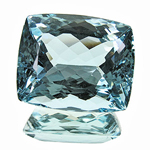
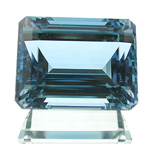
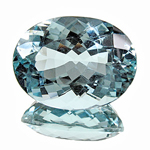
Aquamarines from Brazil
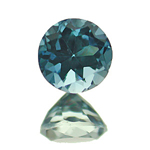
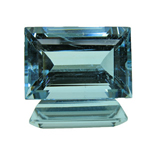
Exceptionally fine aquamarines from Nigeria.
Unfortunately this deposit only yields stones up to about one carat.
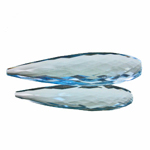
The briolette cut: beautiful but low-yield and labour-intensive
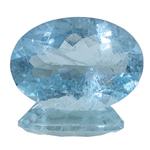
Quite often customers specifically ask for heavily included aquamarines
Handling: aquamarine is sensitive to heat. Many aquamarines are heated to low temperatures of about 400°C to improve their colour. The procedure is legal, acknowledged by the CIBJO, and does not have to be disclosed at the point of sale. In most cases it is impossible to establish whether aquamarine has been heat-treated because at low temperatures (yes, in gem treatment circles 400°C is considered very low, indeed) inclusions do not change their appearance.
Attention: improper heating or heating to high temperatures can cause colour change or even loss of colour. Careful during soldering. Do not clean ultrasonically.
Aquamarine is hard but brittle and susceptible to pressure. Handle with care during setting.
It is also sensitive to acids and will be etched by hydrofluoric acid.
Worth knowing: aquamarine is a good example to show, how favourite colours change in time. In Victorian age green(ish) aquamarines were more popular and more expensive than blue aquamarines. Today the exact opposite is true: the bluer, the better…
Aquamarine is one of very few gems, whose price per carat may decrease as its size increases. The reason is that aquamarine generally needs volume to accumulate colour. In other words, a one carat aquamarine is much rarer than a 20cts stone of the same colour and thus commands a higher price per carat.
For the same reason you should always look at aquamarines individually when buying. In a big lot even pale specimens look grand.
In 1917 deep blue aquamarines where found in the Maxixe mine in Minhas Gerais, Brazil. The fantastic colours had gem lovers abuzz immediately but unfortunately the stones quickly faded upon exposure to sunlight. It is assumed that the colour was due to natural radiation.
Today Maxixe aquamarine, sometimes also called Maxixe beryl, is not available any longer.
 Deutsch
Deutsch